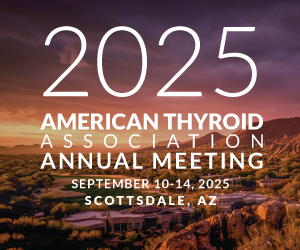Radiation exposure risk from Fukushima and Chernobyl nuclear accidents discussed at largest international thyroid congress in over 5 years
October 19, 2015 — The effect of radiation exposure related to the nuclear accidents that took place in Fukushima, Japan, and Chernobyl, Ukraine on thyroid cancer risk, whether dietary habits influence the risk of developing thyroid cancer, and recent study results with a triiodothyronine (T3) analog in an uncommon form of thyroid disease are all topics featured in oral presentations delivered at the 15th International Thyroid Congress, hosted by the American Thyroid Association, October 18-23, 2015, in Orlando, Florida.
Following the accident at the Fukushima Daiichi Nuclear Power Plant caused by the Great East Japan Earthquake and Tsunami of March 2011, screening for thyroid cancer due to the risk of low-dose radiation exposure was initiated for people in the nearby area aged 18 years or younger. A positive screening result led to diagnostic testing with find needle aspiration cytology. Shinichi Suzuki, Fukushima Medical University School of Medicine, Fukushima, Japan, compared the rate of detected thyroid cancer or suspected malignancy from two rounds of screening of 447,570 asymptomatic young people to the rate of childhood thyroid cancer with clinical symptoms preceding the disaster. The results, described in the poster “Treatment of Childhood and Adolescent Thyroid Cancer in Fukushima after Fukushima Daiichi Nuclear Power Plant Accident on March 11, 2011,” led to the conclusion that the cases of thyroid cancer detected on screening might not be associated with radiation exposure form the Fukushima nuclear accident.
Presenting interim clinical study results on behalf of the Triac Trial research team, Stefan Groeneweg, Erasmus Medical Center, Rotterdam, The Netherlands, reported that treatment of a small group of patients with Allan-Herndon-Dudley syndrome (AHDS) with the T3 analog Triac for, on average, 6 months, decreased serum TSH levels, resulting in a substantial reduction in T3 levels. Preliminary evidence of improvement in the levels of biochemical markers related to disease activity suggests that Triad treatment may have a beneficial effect on symptoms of AHDS.
Researchers exploring the possible role diet might play in thyroid cancer risk analyzed data on more than 61,000 individuals who participated in the Prostate, Lung, Colorectal and Ovarian Cancer Screening Trial, conducted between 1993 and 2009. Michael Singer, Henry Ford Health System, Bloomfield, MI, presented the results of the study in the poster,” Diet and the Risk of Thyroid Cancer: Results from a Large, Prospective Cohort,” concluding that no clear evidence exists to identify dietary habits or consumption of specific foods or vitamins as risk factors for thyroid cancer.
Michael Fridman, Belarusian Medical Academy for Postgraduate Education, Minsk, Belarus, conducted a population-based study to determine whether individuals treated for papillary thyroid cancer in the years following the Chernobyl nuclear accident (1990-2015) are at increased risk of a second primary malignancy (SPM). A SPM developed in 1% of the study group, affecting more women than men. The most common types of cancer were hematologic malignancies and solid tumors of the cervix, breast, and colon, as described in the poster “Second Primary Malignancies in Belarus, Patients with Pos-Chernobyl Papillary Thyroid Carcinoma.”
###
The American Thyroid Association (ATA) is the leading worldwide organization dedicated to the advancement, understanding, prevention, diagnosis, and treatment of thyroid disorders and thyroid cancer. ATA is an international membership medical society with over 1,700 members from 43 countries around the world. Celebrating its 92nd anniversary, the ATA delivers its mission — of being devoted to thyroid biology and to the prevention and treatment of thyroid disease through excellence in research, clinical care, education, and public health — through several key endeavors: the publication of highly regarded professional journals, Thyroid, Clinical Thyroidology, and VideoEndocrinology; annual scientific meetings; biennial clinical and research symposia; research grant programs for young investigators, support of online professional, public and patient educational programs; and the development of guidelines for clinical management of thyroid disease and thyroid cancer. The ATA promotes thyroid awareness and information through its online Clinical Thyroidology for the Public (distributed free of charge to over 11,000 patients and public subscribers) and extensive, authoritative explanations of thyroid disease and thyroid cancer in both English and Spanish. The ATA website serves as the clinical resource for patients and the public who look for reliable information on the Internet. Every fifth year, the American Thyroid Association joins with the Latin American Thyroid Society, the European Thyroid Association, and the Asia and Oceania Thyroid Association to co-sponsor the International Thyroid Congress (ITC). This year the ITC is hosted by the American Thyroid Association at the Walt Disney World Swan and Dolphin Resort. More information about the 15th ITC can be found at http://www.thyroid.org/itc2015/.



